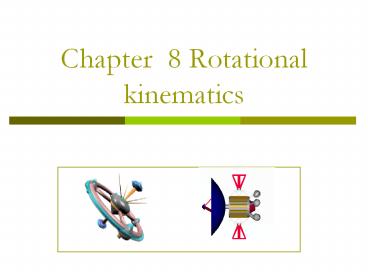Chapter 8 Rotational kinematics - PowerPoint PPT Presentation
1 / 19
Title:
Chapter 8 Rotational kinematics
Description:
Chapter 8 Rotational kinematics Section 8-1 Rotational motion In general the three-dimensional description of a rigid body requires six coordinates: three to locate ... – PowerPoint PPT presentation
Number of Views:207
Avg rating:3.0/5.0
Title: Chapter 8 Rotational kinematics
1
Chapter 8 Rotational kinematics
2
Section 8-1 Rotational motion
The general motion of a rigid object will include
both rotational and translational
components. For example The motion of a wheel
on a moving bicycle A wobbling football in
flight is more complex case.
Rotations with only one fixed point (????)
Rotations
Rotations with fixed axis(????)
pure rotation
3
Two definitions of a pure rotation
- Every point of the body moves in a circular path.
The centers of these circles must lie on a common
straight line called the axis of rotation. - Any reference line perpendicular to the axis
(such as AB in Fig 8-1) moves through the same
angle in a given time interval.
y
B
p
A
x
z
Fig 8-1
4
How many freedoms are needed to describe
completely for a pure rotation?
1(R)
How many for a rotation with only one fixed
point?
3(R)
- In general the three-dimensional description
of a rigid body requires six coordinates three
to locate the center of mass, two angles (such as
latitude and longitude) to orient the axis of
rotation, and one angle to describe rotations
about the axis.
5
8-2 The rotational variables
1. Angular displacement
- Fig 8-4 shows a rod rotating about the z axis.
Any point P on the rod will trace an arc of a
circle. - The angle is the angular position of the
reference line AP with respect to the x axis.
Z
A
P
y
x
6
- We choose the positive sense of the rotation
to be counterclockwise(???). -
(8-1) - where the s is the arc which the point P
moves, and r is the radius (AP). - At time the angular position is , at
is . The angular displacement of P is
during - .
7
2. Angular velocity
- We define the average angular velocity as
- (8-2)
- The instantaneous angular velocity is
- (8-3)
- Is a vector quantity?
8
3. Angular acceleration
- If the angular velocity of P is not constant,
then the average angular acceleration is defined
as -
(8-4) - The instantaneous angular acceleration is
-
(8-5)
Its dimensions are inverse time squared ( )
and its units might be or .
9
8-3 Rotational quantities as vectors
- Commutative addition law for any vectors
Can angular displacements satisfy corresponding
formula???
?
10
- We conclude that
-
and so finite angular displacements
cannot be represented as vector quantities. - If the angular displacement are made
infinitesimal, the order of the rotations no
longer affects the final outcome that is - Hence can be represented as vectors.
11
- Quantities defined in terms of
infinitesimal angular displacements may also be
vectors. - For example, is a vector
- Its direction is determined
- by a right handed system
- Angular acceleration
- is also a vector quantity.
Z
Positive direction
A
P
y
x
12
8-4 Rotation with constant angular acceleration
- For the rotational motion of a particle or a
rigid body around a fixed axis (which we take to
be z axis ), the simplest type of motion is that
in which the angular acceleration is zero. The
next simplest motion is constant. From
Eq(8-5), - , we now integrate on the left
from to and on the right from time 0 to
time t,
13
- We obtain . (8-6)
- And , , integrate
Eq. again, - So ,
(8-7)
14
Sample problem 8-3
Starting from rest at time t0, a grindstone
(?????)has a constant angular acceleration of 3.2
rad/s2. At t0 the reference line AB is
horizontal. Find (a) the angular displacement of
the line AB and (b) the angular speed of the
grindstone 2.7s later.
15
8-5 Relationship between linear and angular
variables
- When a rigid body rotates about a fixed axis,
we have - where s is the distance which the particle
moves along the arc, the radius r is the
perpendicular distance from the particle to the
axis, and is the angle which the rigid body
rotates through.
(8-8)
16
(8-8)
- Differentiating both sides of Eq(8-8) with
respect to the time, and note that r is constant,
we obtain
- Where is the (tangential) linear
speed .
(8-9)
17
- Differentiating Eq(8-9), then
- or
(8-10) - Where is the magnitude of the
- tangential component of the acceleration.
- The radial (or centripetal) acceleration is
-
(8-11)
18
For rotations with fixed axis, we have
rAP
z
A
P
Notate them in vector style
y
o
- Fig 8-11
x
19
Sample problem 8-5
If the radius of the grindstone of Sample
Problem 8-3 is 0.24m, calculate (a) the linear or
tangential speed of a point on the rim, (b) the
tangential acceleration of a point on the rim,
and (c) the radial acceleration of a point on the
rim, at the end of 2.7s. (d) Repeat for a point
halfway in from the rim-that is, at r0.12 m.
At 2.7 s, we have known
r0.24m
(d)
are the same,
r0.12m





























